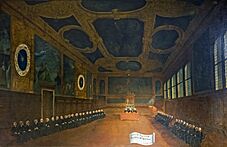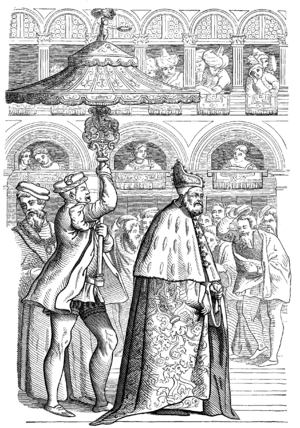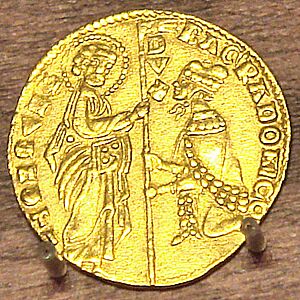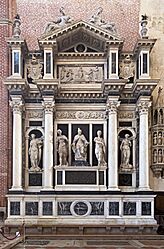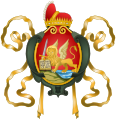Doge of Venice facts for kids
Quick facts for kids Doge of Venice |
|
|---|---|
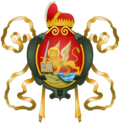
Coat of arms
|
|
|
The last doge, Ludovico Manin
|
|
| Style | His Serenity |
| Residence | Palazzo Ducale |
| Appointer | Serenissima Signoria |
| Formation |
|
| First holder |
|
| Final holder | Ludovico Manin |
| Abolished | 12 May 1797 |
| Salary | 4,800 ducats p.a. (1582) |
The Doge of Venice (pronounced DOHJ) was the most important leader in the Republic of Venice. This powerful republic existed for over 1,000 years, from 697 CE to 1797 CE. The word "Doge" comes from the Latin word Dux, which means "leader."
The Doge was like both the president and the main leader of the Venetian government. Doges were chosen for life through a very detailed voting process. They led the city-state of Venice, which was a major trading power.
Contents
History of the Doges
Early Doges and Byzantine Influence
The first Doge of Venice, Paolo Lucio Anafesto, was chosen in 697 CE. He served until 717 CE. At first, Venice was part of the Byzantine Empire. This meant the Doge was under the Byzantine emperor's rule. Venice became truly independent around 742 CE.
Not much is known about Anafesto's life or death. Some stories say he died in a plot by nobles in 717 CE. Others suggest he died in battle later on.
Marcello Tegalliano was the second Doge, ruling from 717 CE to 726 CE. During his time, Venice faced problems. There were disagreements between different groups in the region.
Later Doges started using grand titles. These titles showed their connection to the Byzantine Empire. For example, they were called "master of the soldiers" or "imperial duke." These titles also showed that Venice was still somewhat linked to the Byzantine rulers.
As the Byzantine Empire's power faded, the Doges changed their titles. They simply called themselves "duke of the Venetians." This showed that Venice was becoming more independent. The plural "Venetians" meant they ruled over several towns and groups.
Expanding Power: Dukes of Dalmatia and Croatia
In 1000 CE, Doge Pietro II Orseolo won battles against Croatia. He also took control of some land in Dalmatia. After these victories, he added "Duke of Dalmatia" to his title. This new title was recognized by other powerful rulers.
Later, the Doges also added "Duke of Croatia" to their full title. This happened as Venice gained more influence in the region. So, the Doge's full title became very long. It included "Duke of Venice, Dalmatia and Croatia."
The phrase "by the grace of God" also became a regular part of the Doge's title. This showed that their power was believed to come from a divine source.
Changes After the Fourth Crusade
A big change happened after the Fourth Crusade in 1204. During this crusade, Venice helped conquer the Byzantine Empire. After this, the Doge's title changed again. It now included a claim to a large part of the conquered Byzantine lands.
The new title was "Duke of the Venices, Dalmatia and Croatia, and lord of a fourth part and a half of the whole Empire of Romania." This showed Venice's huge new power. This part of the title was first used by Venice's leader in Constantinople. Then, Doge Pietro Ziani adopted it for himself.
However, this grand title was not always used. When Venice dealt with the Byzantine emperors, they used a simpler title. It said "lord of the lands and islands subject to his dogate."
A treaty in 1358, called the Treaty of Zadar, ended a long argument between Venice and Hungary. Venice gave up its claims to Dalmatia. Because of this, "Dalmatia and Croatia" were removed from the Doge's title. From then on, the title was simply "Duke of the Venices and the rest." Even when Venice regained Dalmatia later, the title stayed the same until the republic ended.
How a Doge Was Chosen
The Doge's powers were not always clear. At first, some Doges tried to make their sons their successors. But a law was passed to stop this. No Doge could choose a family member to take over. This prevented Venice from becoming a hereditary kingdom.
After 1172, a special committee of forty people chose the Doge. These forty were picked by four men from the Great Council of Venice. The Great Council itself was chosen by twelve people.
In 1229, there was a tie vote for a Doge. So, the number of electors was increased to forty-one.
New rules for electing the Doge were set in 1268. These rules stayed until the end of the republic in 1797. They were designed to stop powerful families from having too much influence. The process was very complicated:
- Thirty members of the Great Council were chosen by drawing lots.
- These thirty were reduced to nine by drawing lots again.
- The nine chose forty people.
- The forty were reduced to twelve by drawing lots.
- The twelve chose twenty-five.
- The twenty-five were reduced to nine by drawing lots.
- The nine elected forty-five.
- These forty-five were reduced to eleven by drawing lots.
- Finally, the eleven chose the forty-one people who would elect the Doge.
To win, a candidate needed a certain number of votes from these electors.
Before becoming Doge, the chosen person was shown to the people. The people would say, "This is your doge, if it please you." This showed that the people agreed. But this tradition ended in 1423. After that, the Doge was simply presented with "Your doge."
Rules for the Doge
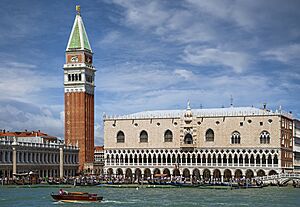
While early Doges had much power, after 1268, their actions were closely watched. The Doge could not open letters from other countries alone. He also could not own land in foreign countries.
Doges usually ruled for life. But some were forced out of office. After a Doge died, a group of officials would review his actions. If they found any wrongdoing, his family's property could be fined. The Doge's official salary was not very high. Many Doges continued to be involved in trading. This helped them stay connected to the needs of the powerful families.
When the Doge's office was empty, the senior ducal counselor would lead the state. He was called the vicedoge.
Special Ceremonies and Role
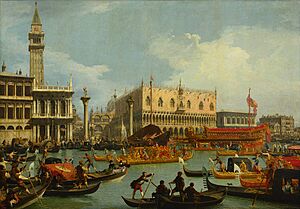
One important duty of the Doge was the symbolic "marriage of Venice with the sea." This ceremony involved throwing a ring into the Adriatic Sea. It was done from the state ship, called the Bucentaur. This ceremony celebrated Venice's control over Dalmatia. It also became more grand after a visit from Pope Alexander III in 1177.
On special occasions, the Doge would be part of grand processions. These parades started in Piazza San Marco. The Doge would be in the middle of the procession. He was surrounded by officials and nobles. These ceremonies showed the Doge's important status as a ruler.
Doge's Special Clothes
From the 14th century, the Doge's special crown was called the corno ducale. It was a unique hat shaped like a horn. It was made of rich, decorated fabric. The Doge wore it over a fine linen cap called a camauro. This cap had a pointed top, like a symbol of freedom.
Every Easter Monday, the Doge led a procession to a convent. There, the nuns would give him a new camauro they had made. The Doge's official costume also included golden robes, special slippers, and a scepter for ceremonies.
Death and Burial
Until the 15th century, Doges were usually buried at St Mark's Basilica. After that, all later Doges were buried at the Basilica di San Giovanni e Paolo. Twenty-five Doges are buried there.
End of the Doge's Office
Over time, the Doge's power became more symbolic. Many of his important duties were given to other officials. The Doge became mostly a representative figure.
The last Doge was Ludovico Manin. He stepped down in 1797. This happened when Venice came under the control of Napoleon's France. Even though Venice tried to become a republic again, the title of Doge was never brought back.
See also
- Doge of Genoa
- Senarica
- Signoria of Venice
- Sortition
Images for kids
-
The last doge, Ludovico Manin
-
The Doge's Palace complex.
-
The Return of the Bucentaur to the Molo on Ascension Day (1730 by Canaletto)



